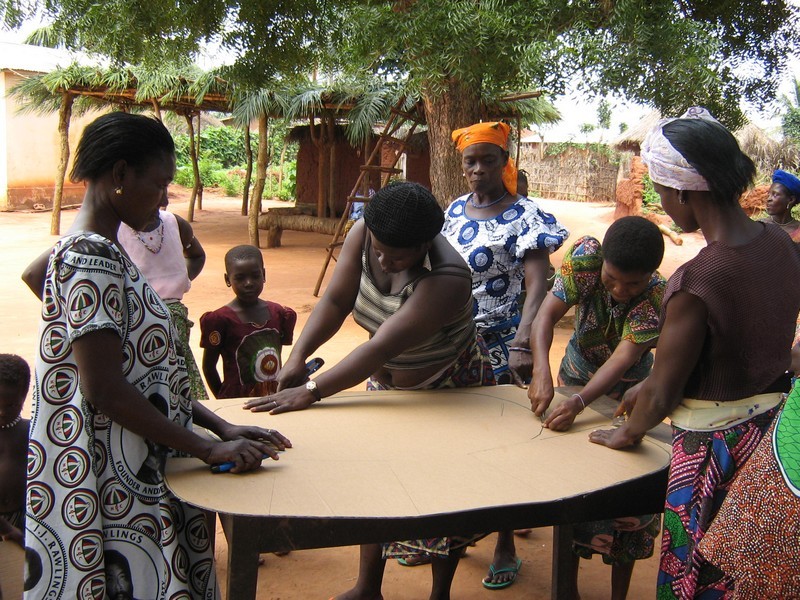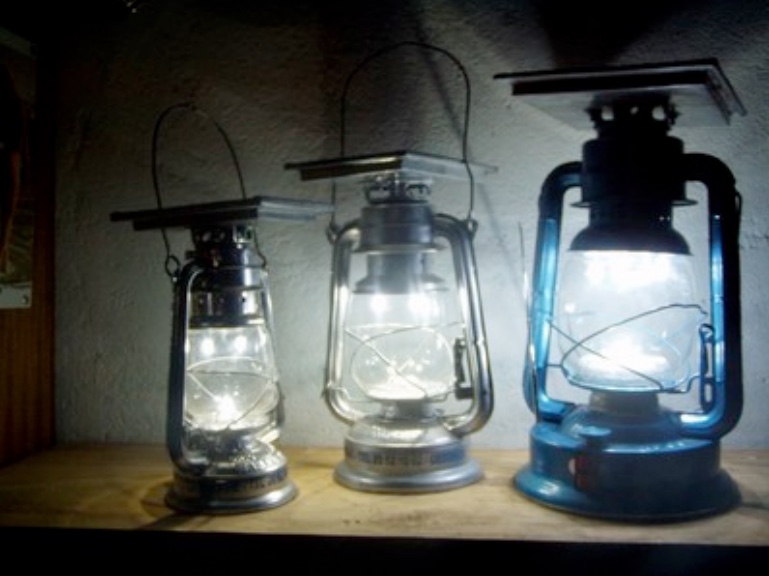To empower rural women to play a greater role in the community by providing them with new skills and access to renewable energy

This project - launched by Jeunes Volontaires Pour l'Environnement - aimed at combining the potential of micro-credit and solar electricity, with that of women's empowerment and thereby address poverty, climate change, and gender inequity. A microfinance system enabled women, organized in "Solar Women's Groups", to set up small businesses to convert existing petroleum lanterns into LED solar lanterns. With adequate business training and technical advice, women were able to pay back the cost of the solar device as well as reimburse the loans while improving their livelihoods through the extra income.
Background
In rural Togo many people lack access to clean, adequate and affordable energy sources. To meet their lighting needs, most households rely on kerosene lamps, which are expensive and cause indoor air pollution affecting the health of the inhabitants. Women especially have expressed their desire to improve this situation. According to a recent survey (Solar Water Pasteurization Project, 2006 Report, JVE), about 82% of the women in southern Togo believe that access to a clean and affordable source of energy would help them to improve their livelihoods and support local development.
To address these hopes and to give some of these women the chance to improve their living conditions by starting their own businesses, Jeunes Volontaires Pour 'Environnement initiated this project. The main objective of the project was to combine solar technology for lighting and micro-credits to empower rural women. Taking advantage of the existing structures in form of local women's groups, the project was implemented in the Vo district, where 95% of the population has no access to electricity.
Unfortunately the original planned project approach had to be adjusted in many ways. Instead of re-using and recycling existing lamps locally, the solar lamps had to be imported, which resulted in higher costs and less income-generating options for the participants involved. However, lighting in some community groups was improved. In addition, a community financial system (AVE&C) based on the traditional technique of savings has been implemented and well accepted by the women's groups.
Technology, Operations and Maintenance
Initially the intention of the project was to train the local women to convert traditional gas and kerosene lamps into solar lamps. The women would have been responsible for selling the lamps and doing the maintenance to ensure long-term sustainability. Unfortunately, however, the project partner who was responsible for the local conversion of the lamps and the technical training of the women withdrew from the project. No other partner with the required skills and knowledge, and who would have been able to provide the training, could be found in Togo. Therefore, the project team of Jeunes Volontaires pour l'Environnement decided to purchase solar lamps from CB Energy in Burkina-Faso. This change in the project design led to further obstacles along the way but in the end a total of 210 lamps with preinstalled solar panels were purchased and imported into Togo.
Financial Issues and Management
Originally the project strategy was to offer finance opportunities in the form of micro loans to the local women. However, because the interest rates offered by the micro finance partners were too high, the local communities rejected this option. Furthermore, the women disliked the idea of micro finance because other NGOs had already tried to introduce this system without success. On the other hand, they showed great interest in the idea of the AVEC (Association Villageoise pour l'Epargne et de le Crédit) system. This is a modification of an older community saving system called "tontine". Under this system participants have to wait until their individual savings are sufficient before applying for a loan.
The initial payback period was set at six months, but because of the high cost of solar lamps, it was decided that the repayment period should be extended to eleven months. Despite this, the women's groups still had difficulties in repaying their loans - mainly because they could not generate sufficient income from the lamp sales. They claimed that due to the high cost of purchasing the solar lamps, it was barely profitable to sell them. Consequently, only a few women started solar businesses compared to the original target of 250. Those women who were trained in maintenance and did establish a business still have the opportunity to earn some income from repairing the lamps at community level.
Environmental Issues
Replacing gas and kerosene lamps with solar lamps reduces greenhouse gas emissions. Indoor air pollution is also reduced and the introduction of solar lamps can represent the first step towards the adoption of eco-friendly habits in rural communities.
Social Issues
The initial idea was to empower women by providing them with the necessary training and skills to run their own solar businesses. However, because of changes made during the project implementation the women could only establish businesses that sell and repair the imported lamps. Many of them were not convinced by, and satisfied with, this new business model, so in the end only a few women decided to run a solar business.
Furthermore, it became clear that it is important to integrate the participants from the start. Communities do not want to be considered solely as beneficiaries but as local partners. For example, changes to the finance model had to be made because the women preferred a form of the traditional finance system instead of the micro finance system that was initially offered. By integrating the local participants at an early stage of the project development phase these types of preferences can be identified and incorporated into the overall concept of the project.
Results & Impact
The project aimed to provide business opportunities for 250 women and to convert 1200 lanterns into solar lamps but, due to major difficulties faced during the implementation of the project, to date only 30 lamps have been sold to nine community groups. 20 of these lamps have, unfortunately, already had to be exchanged due to defects.

Replicability
In general solar lamps offer good potential to improve living conditions in rural African communities. However, although some users have expressed their satisfaction with the newly acquired solar lamps, it is questionable if the project design itself can be replicated without establishing production within Togo. Importing the technology proved to be expensive and difficult and orders for new lamps have to be placed several months ahead, which reduces the overall sustainability of the technology implementation.
Action was taken to promote the technology within the region, as a first step to spreading knowledge and information about solar lamps. This included the provision of leaflets and posters to be displayed at the solar shop at Vogan, which helped to demonstrate the technology and the functions of the lanterns.
Lessons learned
Although the project faced several challenges during the implementation phase, resulting in several changes and delays, some valuable lessons were learned. These experiences provide useful insights for designing future projects that plan to implement solar technology in Togo.
In the main, the difficulties occurred because instead of converting the existing lanterns, solar lamps had to be purchased in Burkina Faso. That meant that the local women were not trained in the construction of the lamps but only in their maintenance. Furthermore, import taxes of between 40% and 53% would generally be payable for this type of product. Paying this tax would have made the lamps unaffordable for the rural communities so, to avoid these costs, the project team had to negotiate with government agencies. This resulted in long delays before the lamps could be delivered. It is questionable if long-term sustainability and successful dissemination can be assured without the local construction component. Therefore, it is essential to guarantee that expertise and know-how for the key parts of the project are locally available.
Another factor that hindered the implementation was the high illiteracy rate within the communities, which meant that alternative methods of spreading knowledge and information had to be established.
Projects with same technology
Village Micro-Factories For Led Based Household Lighting Systems
To improve access to low cost lighting by working with rural-based entrepreneurs